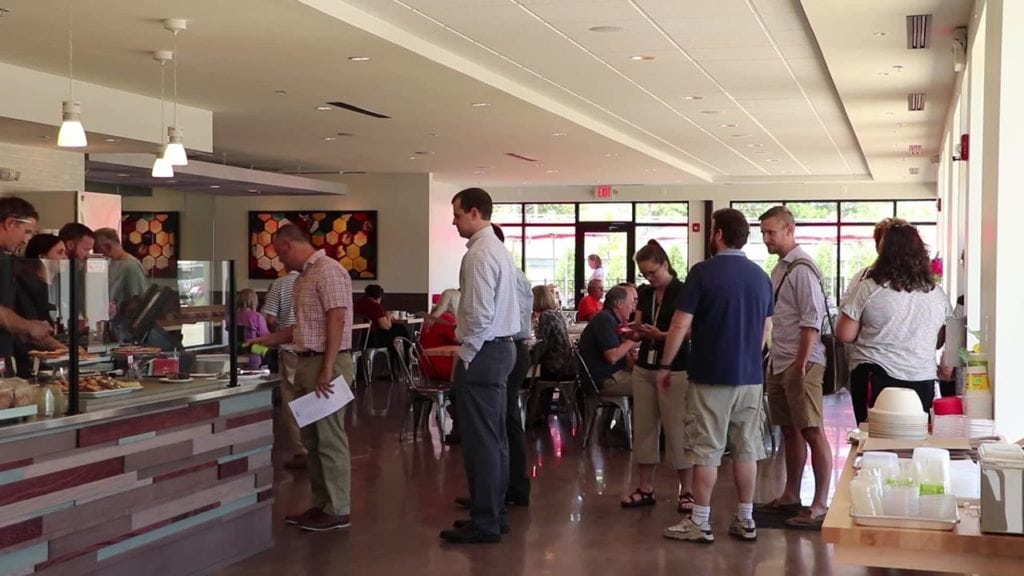It’s one thing to talk about eliminating tipping, but how does that actually play out for restaurants outside of dining hotspots like New York and San Francisco?
The success of a new model depends on plenty of factors, including specific local details and regulations, but these examples detail how restaurants can implement similar policies through different approaches. Haymarket Cafe (Northampton, Massachusetts), Delta Diner (Delta, Wisconsin), and Hive (Bloomington, Indiana) have all done away with tipping. All are casual or fast casual dining spots, two are counter service, and all have average check sizes under $25. Haymarket and Delta Diner eliminated tipping in 2015, and Hive launched with a no-tipping model nine weeks ago.
Each owner cautioned that they are just one example. Their model worked for them but is not necessarily transferable to a different restaurant concept operating in a vastly different market. Each approached the concept differently and found that moving away from a business model that relies on tips drastically helped reduce turnover, combated the gaping pay disparity between the front and back of house, and fostered a much more productive work environment.
None of the restaurants featured would consider reverting back to tipping now that they have implemented their new system.
HAYMARKET CAFE
Northampton, Massachusetts
Peter Simpson eliminated tipping at Haymarket Cafe, his casual all-day eatery in Northampton, Massachusetts, in November 2015. Previously, the 20-person team at Haymarket was split into two wage brackets: non-tipped kitchen staff made an average of $12 an hour, and tipped waitstaff made a subminimum wage of $5 an hour. With tips included, the waitstaff averaged $13 an hour.
Simpson, who has always worked in restaurant kitchens, was never comfortable with a number of issues around tipping. It’s not a stable income, he explained, and a high paycheck was typically dependent on securing the busiest shifts, which left waitstaff more vulnerable to harassment if a manager decided to abuse their power to dole out those shifts.
The pay discrepancy between tipped and non-tipped employees was also a problem, especially on those busy days. “I started the cafe with my brother, who always worked front of the house,” Simpson told Skift Table. “At the end of the night, I’d be like, ‘Wow, I made $110 bucks. And you made $250. And I got here four hours earlier.’”

Three years ago, Simpson called an all-hands meeting to discuss a potential new model with his staff. He addressed his employees directly and laid out his concerns. He told everyone that the wait staff was averaging $3 an hour in tips after reaching the $10 base minimum wage requirement. (On average, customers tipped between 15 and 20 percent.) If that money was spread across the entire house, then everyone’s base wage would go up by $2 an hour. He then looked everyone in the eye and asked them how they felt about that.
“What are these tips for?” Simpson recalled saying in the meeting. “Are they just for you, because you are the one who interacted with the customer? Or, did the person who works in the kitchen, making that food, do they get any access to that gratuity?” The staff showed strong support for sharing the money, which Simpson credits to the fact that the meeting took place with everyone in the room.
Since Simpson couldn’t actually give tips to the kitchen staff, as tip pooling is illegal in Massachusetts, the meeting was one more measure of support for eliminating tipping. He approached four other cafes in town, hoping to convince the owners to go no-tipping with him, but no one agreed. So, in November 2015, he went for it alone, raising menu prices by 10 percent in the upstairs cafe and 20 percent in the downstairs restaurant. The base wage for every employee started at $14 an hour, calculated to remain consistent with what the average tipped wage had been.
“I was petrified,” Simpson admitted. Northampton is a small town. It averages about 30,000 residents, according to 2010 U.S. Census data, not including the seasonal influx of students from surrounding colleges. The average household income is $51,018. There are 128 establishments that serve food in the city, according to the mayor’s office, 69 of which are categorized as restaurants. There was no guarantee that the community could support a cafe with notably higher menu prices than the competition.
Now, Simpson is proud to say that not only did he not lose customers but he saw an increase in traffic to the cafe. The public communication was very clear: Haymarket was raising its prices entirely to support staff wages while eliminating tipping. There were more staff meetings to talk about how to best convey the message in a 45-second conversation with a skeptical diner. A 150-word explanation was printed on every menu.
Operations changed, too. Haymarket moved to a counter service model. It wasn’t feasible to support the staff required for table service during the cafe’s full opening hours, 7am to 10pm, now that their wages rose by nearly 200 percent. A couple of employees left immediately after the switch, preferring to work in a tipped system.
The benefits are clear now. Before Simpson eliminated tipping, he had to hire two to three new people a year. He hasn’t had to fill any open spots in 2018, and hasn’t had to hire anyone in the kitchen for several years. Customer service has improved thanks to better staff relationships with customers, and Simpson doesn’t have to sink time and effort into constantly training new employees. The kitchen staff and service staff have a much better relationship as well, because they are all on the same wage scale.
“The repercussions — I couldn’t believe it, having worked in the service industry all of my life,” Simpson said. “There was none of that tension that usually happens between the front and back of house.”
Labor costs currently run at about 42 percent of Haymarket’s budget, but Simpson said that other costs are proportionally lower: food accounts for 27 percent of the budget and other operational costs take up the remaining 31 percent. As for profit? Simpson laughed at the question. The cafe doesn’t turn a profit — it just breaks even — but that was always the case, even before eliminating tipping. “For me, that’s a successful business,” Simpson said. “I’ve been open for 28 years now, and [high profits] have never been an objective for me.” Haymarket is solely owned by Simpson; there are no outside investors in the business.
DELTA DINER
Delta, Wisconsin
Todd Bucher eliminated tipping from his diner in June 2015. Bucher told Skift Table that the decision wasn’t driven over concern that his waitstaff wasn’t making enough money; Delta Diner is a tourist destination, and customers often tip between 22 to 25 percent during the restaurant’s busy season.
Instead, Bucher’s concerns centered around the overall working environment that tipping promoted. Due to the tip structure, there was a vast pay discrepancy between his servers and cooks. After an eight to nine hour shift, a top-earning server could walk out the door with $400 during the diner’s busy season. A cook working the same shift earning $10 to $11 an hour wouldn’t break $100. Bucher wanted to attract employees that were invested in the success of the business, a tall order when the cooks were scraping by and service staff’s top priority was whatever work brought in the most tips.
When Bucher eliminated tipping, he transitioned four core staff members onto a salary that was at or above their previous wages, which he says helped mitigate the typical service staff exodus that happens after a restaurant gets rid of tipping.

In the new model, adults start at $15 an hour and students start at $10 an hour. (Adults are defined as those with unrestricted working hours, while students require a restricted schedule.) The diner hires seasonal workers from May to October to handle the summer tourist slam, and for those employees, Bucher developed a seasonal contract two years ago where those workers make $12.50 an hour during the season, and then are paid a $2.50 an hour bonus upon completion of the season. “We don’t have people walk out anymore,” Bucher said of the new pay structure, which was an issue especially during the diner’s busy season. The completion rate for seasonal workers is now over 90 percent.
In the year immediately after eliminating tips, Bucher’s payroll costs rose by 85 percent, accounting for nearly 50 percent of the diner’s total sales. To compensate, Bucher added a pre-tax charge of 20 percent to every bill. He (and his employees) refer to it as a menu price increase that doesn’t show up on the menu. The price increase is labeled as such and highlighted as a separate line item on the bill to clearly communicate to customers that this money is directly funneled into Delta Diner’s labor costs.
Bucher says that there was no significant customer blowback after the service charge was initiated. In fact, as Bucher sees it, because the wait staff was averaging up to a 25 percent tip in the old model, he “essentially gave [customers] a price decrease.”
Again, clear communication on the service charge is key to gaining customer support. Unless a diner is a known regular, every server follows their standard greeting with a short spiel on how Delta Diner has “eliminated tipping from the business model” and raised menu prices to compensate. The price is not reflected on the menu board, but the charge will come as a separate line item on the bill.
The diner’s labor costs ran at 43 percent last year, and Bucher wants to get that down to around 36 percent. However, he plans on maintaining a 40 percent revenue share with staff, which he explains as even if labor costs settle below 40 percent, a full 40 percent of sales still goes towards staff compensation in some way, through discretionary bonuses and similar perks.
The restaurant is projected to generate a 30 to 40 percent growth in revenues within five years after eliminating tipping, which Bucher credits to the new labor model. His core team is much more efficient, turnover is down dramatically across the restaurant, and he now can look at investing in more special events and other ways to drive profit now that he has a stronger, more reliable staff. The diner operated on a 5 percent profit margin in 2017. Bucher believes that the diner can eventually hit a 13 to 15 percent profit margin with this new operational structure.
HIVE
Bloomington, Indiana
Jeff Mease opened the doors to Hive just over eight weeks ago. The fast casual, all-day restaurant employs around 45 staff members and opened as a no-tipping restaurant. It’s the only restaurant to do so out of a handful of different concepts that Mease co-owns and runs at One World Enterprises, alongside his business partner Lennie Busch.
As Mease was getting ready to launch Hive, he asked people in the community to share their views on tipping at fast casual, counter service restaurants like the one he was about to open. Often, he heard back that people didn’t understand it. They didn’t know how much of a tip was expected and it was confusing since they were still very involved in the service aspects, from ordering at the counter to bussing their own tables.
Given the feedback, Mease felt confident that he could make Hive work with a no-tipping model. When the restaurant opened, he started with menu prices about 20 percent higher than the competition in order to make up for the increased labor costs. When customers push back on the price — and they sometimes do — Mease reminds them that there’s no tip involved, and he points to the higher-quality ingredients that Hive is sourcing as well to justify the premium prices.

The front-of-house staff ranges from $8 to $10 an hour, which Mease feels is appropriate given that at Hive, this is an entry-level job and is typically filled by high school students. The majority of the labor costs go towards funding management wages and the kitchen staff, where Mease wants to attract highly skilled workers. He’s aiming to pay back-of-house staff between $14 to $18 an hour, about double what the front-of-house staff makes. Currently, most of the kitchen staff averages between $11 and $12 an hour.
All of Mease’s costs at Hive are high right now since the restaurant is still new. Labor costs run at about 60 percent due to training and overtime stacked on top of the higher base wages. Hive is currently losing a considerable amount of money, as opening costs drive profits down somewhere in the negative 40 percent range. (“You lose your a** for awhile when you’re opening up a restaurant,” Mease chuckled.) However, Mease estimates that Hive will start generating a cash flow by next year and will eventually post profits in the same 4 to 7 percent range as the other restaurants he owns.
Even if Hive succeeds, which Mease is confident that it will, he says that he wouldn’t eliminate tipping at any of his other restaurants. In his view, customers like to tip at full-service restaurants, and the financial reality of reversing a labor model that relies on tipping, like at his 30-year-old casual dining restaurant, Lennie’s, would be too difficult.
JUST THE BEGINNING
No matter which way it’s dealt with, the prospect of eliminating tips, especially when it requires retooling a system already in place, is hard. None of the three owners interviewed for this story would disagree even though none would say that they miss the tipping model. Bucher said that he saw several restaurants in his area that went no tipping after Delta Diner and then reversed back to tipping when sales couldn’t support the model.
“You have to be somebody who is willing to look at the long haul,” Bucher said. “How long of a haul depends on your current work culture, and how you run your business.”
While examples like these new models are few and far between for now, the minimum wage increases (and debate over eliminating the tip credit) in cities across the U.S. are pushing labor costs up in a way that owners are now being forced to deal with. In Northampton, the city just passed legislature to install a $15 minimum wage by 2022. At Haymarket, Simpson currently pays his staff a starting wage of $15.50. No other restaurant in town has followed him in eliminating tipping yet, but Simpson wouldn’t be surprised if that starts to change as the traditional restaurant labor model is less and less fitting for the current economy.
Want to see more content like this? Subscribe to the Skift Table Daily Newsletter!
